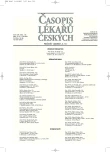Comparison of the Efficacy of ESWL and Ureteroscopy in the Treatment of Lower Ureteric Stone
Porovnání účinností extrakorporální litotrypse a ureteroskopie při primární terapii ureterolitiázy dolní třetiny ureteru
Východisko.
Stále diskutovanou otázkou je, zda je úspěšnější ESWL či ureteroskopie při léčbě juxtavezikální ureterolitiázy. Práce si klade za cíl porovnání efektivity obou metod, se zřetelem na posouzení jejich efektivity a bezpečnosti.
Metody a výsledky.
Do retrospektivní studie k porovnání terapie litiázy dolní třetiny ureteru byli vybráni pacienti s litiázou dolní třetiny ureteru, kde daná metoda byla prvním výkonem, a bylo dokončeno sledování ve třech měsících. Do souboru terapie ESWL in situ bylo zahrnuto celkem 395 případů (u 390 pacientů). Do souboru ureteroskopické terapie 509 případů (u 501 pacientů). Při porovnání ureteroskopie a ESWL v terapii ureterolitiázy dolní třetiny ureteru byla jednoznačně prokázána vyšší efektivita ureteroskopie oproti ESWL. Při hodnocení v odstupu tří měsíců nebylo zaznamenáno rozdílu v stone free rate (97,72 % vs. 98,40 %, p=0,4675), avšak je rozdíl v efektivitě signifikantní (EQ dle Rassweilera 43,52 vs. 89,60, p<0,0001). Jednoznačný je zejména rozdíl při hodnocení po 48 hodinách od výkonu (stone free rate 64,81 % vs. 96,46 %, p<0,0001). Ureteroskopie byla doprovázena vyšším výskytem komplikací jak během (0,67 % vs. 6,36 %, p<0,0001) tak i po výkonu (6,55 % vs. 11,95 %, p=0,0018), avšak tyto komplikace nebyly závažné. ESWL je naproti tomu zatíženo vyšší četností opakování výkonu (51 % vs. 2 %, p<0,0001) a nutností následných auxiliárních výkonů (25,87 % vs. 6,36 %, p<0,0001).
Závěry.
V provedené práci bylo prokázáno, že ureteroskopie představuje efektivnější metodu oproti ESWL v terapii litiázy dolní třetiny ureteru. Ureteroskopie dosahuje okamžitého efektu s minimální nutností opakování výkonu a užití následných auxiliárních metod, vyjma nutností odstranění při výkonu zavedeného double pig tailu. Nevýhodou ureteroskopie je nutnost užití celkové anestezie a vyšší výskyt komplikací během a po výkonu, které však ve většině případů nebyly závažné.
Klíčová slova:
ureterolitiáza, terapie, ESWL, uretroskopie.
Authors:
A. Petřík
Authors‘ workplace:
Urologické oddělení Nemocnice České Budějovice, a. s.
Published in:
Čas. Lék. čes. 2007; 146: 776-780
Category:
Original Article
Overview
Background.
The efficacy of ESWL and ureteroscopy in the treatment of lower ureteric stone is still discussed. The aim of the study is to compare efficacy and safeness of both methods.
Methods and Results.
A retrospective study comparing the treatment results of distal ureteric stones was performed. The inclusion criteria were: distal ureteric stones with no previous treatment and an accomplished three months follow-up after the treatment. There were 395 cases (390 patients) included in the ESWL group and 509 cases (501 patients) in the ureteroscopy group. Higher efficacy of ureteroscopy as opposed to ESWL therapy was marked. There is no significant difference in stone free rate in three months after the treatment (97.72 % vs. 98.40 %, p=0.4675), but there is a significant difference in EQ according to Rassweiler (43.52 vs. 89.60, p<0.0001). The main difference is in evaluation in 48 hours after the treatment (stone free rate 64.81 % vs. 96.46 %, p<0.0001). Ureteroscopy has a higher incidence of complications during the therapy 0.67 % vs. 6.36 %, p<0.0001) as well as after the therapy (6.55 % vs. 11.95 %, p=0.0018), but the complications are minor. On the contrary ESWL treatment is accompanied by a higher re-treatment rate (51 % vs. 2 %, p<0.0001) and higher incidence of auxiliary procedures (25.87 % vs. 6.36 %, p<0.0001).
Conclusions.
It has been clearly proven that ureteroscopy is more efficient in the treatment of distal ureteric stones than ESWL. The main advantage of ureteroscopy is the immediate effect, low re-treatment rate and low incidence of auxiliary procedures, except the need of removing the J-J stent. The disadvantage of ureteroscopy is the requirement of general anaesthesia and a higher incidence of complications after the treatment, though only minor ones in most of the cases.
Key words:
ureteric stone, therapy, ESWL, ureteroscopy.
Labels
Addictology Allergology and clinical immunology Angiology Audiology Clinical biochemistry Dermatology & STDs Paediatric gastroenterology Paediatric surgery Paediatric cardiology Paediatric neurology Paediatric ENT Paediatric psychiatry Paediatric rheumatology Diabetology Pharmacy Vascular surgery Pain management Dental HygienistArticle was published in
Journal of Czech Physicians

- Metamizole vs. Tramadol in Postoperative Analgesia
- Advances in the Treatment of Myasthenia Gravis on the Horizon
- Metamizole at a Glance and in Practice – Effective Non-Opioid Analgesic for All Ages
- Spasmolytic Effect of Metamizole
- The Importance of Hydration in Wound Healing
Most read in this issue
- Painful Bladder Syndrome in Interstitial cystitis: Relation Between Symptoms, Endoscopy and Biopsia Results and the Treatment Effects
- Microsurgical Subinguinal Varicocelectomy in Children and Adolescents
- Long-term Results of Uretroplastic Operations Using Buccal Mucosa in Different Modifications
- Radical Cystectomy in the Treatment for Bladder Carcinoma: Results of 125 Operated Patients
